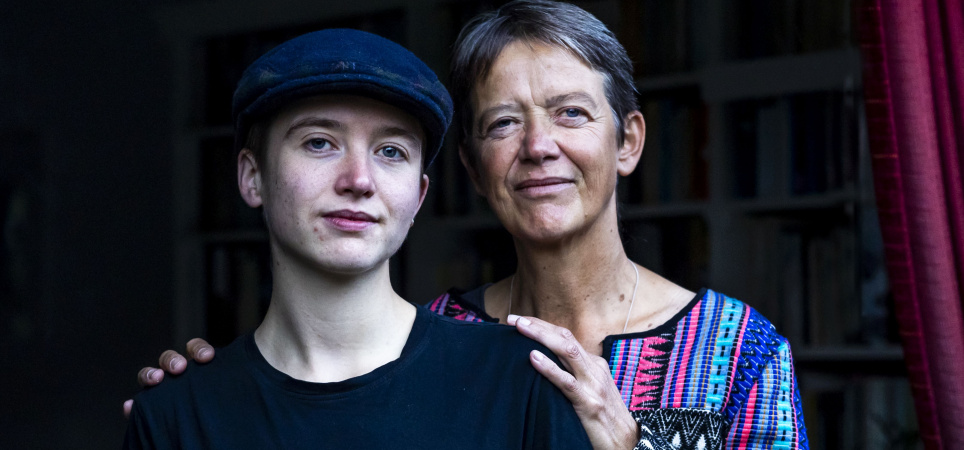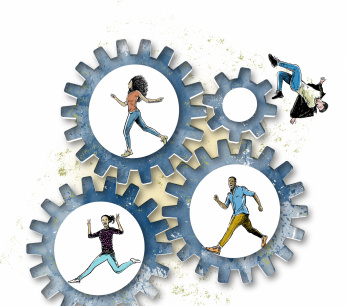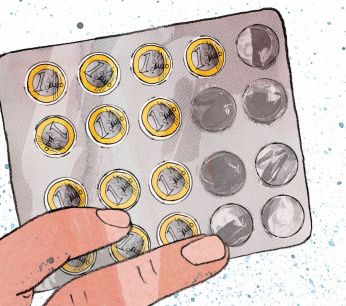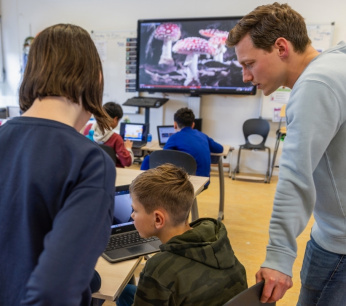In a safe classroom, students express their identity
Dutch teacher Merlijn Borsboom is preferably addressed with them or them. Together with mother Paula Borsboom - former teacher and gay activist - Merlijn works for more open and safe education.

Image: Angeliek de Jonge
Teachers should ask students on the first day of school how they would like to be addressed. That is what Merlijn Borsboom and fellow teacher Nienke Draaisma argue in an opinion piece which appeared last fall in Trouw. "For adolescents, the freedom to explore who they are is very important," the authors write. At a time when young people can freely express their identity on social media, schools must follow suit. 'The online world gives everyone the autonomy to express their own identity. In school, students do not have a profile page, only their appearance on the basis of which a teacher must determine how to address someone.'
In an interview with the Education magazine teacher Merlijn Borsboom tells how they* approached this in the second class of the Stedelijk Gymnasium in Utrecht. Students were asked to write a short biography.
At first Borsboom did that himself. In addition to name, profession and background, the teacher wrote on the blackboard: 'non-binary, and preferably addressed to them or their'. “After that I invited my students to do the same, make their own biography, but I also said they were under no obligation.”
Support
Merlijn Borsboom receives support and support from mother Paula Borsboom, a recently retired college teacher and former union member. Together they work for a more open and safer education. The current time reminds Paula of her early days in education. The forerunner of the AOb, the Abop, was an active member of the International Lesbian and Gay Association in the XNUMXs. As a representative of the Abop, Paula took part in conferences of the international gay organization and gave workshops to teachers about norm-breaking education.
She notices the parallels between then and now. “At the time, many teachers had a blind spot for students who struggled with homosexuality and felt unseen and unsafe at school. I compare it to transgender people. For a long time I thought I didn't have transgender people in my class. Now I know that's not true. I did have them, of course they were there, but I didn't know."
I did have transgender people in class, but I didn't know it
According to research by Movisie, 9 percent of girls and 7 percent of boys are 'also', 'exclusively' or 'mainly' attracted to the same sex. According to research by the Social and Cultural Planning Office, 3,9 percent of the Dutch population does not identify unequivocally with the sex registered at birth. In total, 0,6 percent indicate that they have problems with the assigned birth sex and that they have undergone or want to undergo hormone treatments or surgery. About 0,7 percent of students in secondary education feel different from the assigned gender, which is slightly less than three children in a school of two thousand students.
These are numbers that every teacher should know, according to Merlijn and Paula. According to the two, it does not immediately mean that every teacher has to do something with it, but being informed is the least. “Then you pick up on the signals,” says Paula. “Then you understand why someone sits alone, or behaves the way they do.”
Reassured
After Merlin presented their biography to the class, some students were afraid of making a mistake in addressing the teacher. “Students were scared right zij en her to use instead of hen en have an updated says Merlin. “But I reassured everyone. I said it's about principle. That I am happy to be able to indicate my preference and that I am happy when I see that they are doing their best.”
The conversation about gender was thus opened from the first day of school. Borsboom already got a student at the table who indicated that he felt doubts and wanted to talk about it. “I asked the student if he/she/them would have come to me if we hadn't discussed the topic, and he/she/them said they didn't.”
Our students should be given the opportunity to think for themselves
The teacher and former teacher wish all students to feel safe at school. “If a student has to hold the pee because he, she or them does not know which toilet to go to, then that is terrible,” says Merlijn. The Stedelijk Gymnasium in Utrecht now has one gender-neutral toilet. It's a start. Creating gender-neutral toilets is not that difficult, Merlijn knows. You remove the symbols for man and woman, done. Everyone goes to the same toilet, just like at home.
Safety goes further than furnishing a school building. If a student does not feel safe in the classroom, hardly anything is learned in the lesson. During Merlin's high school days, gender was hardly discussed, if at all. “I had one teacher who was gay and with that an example. I didn't get to know the term non-binary until I was 22. I would have liked to have known about it earlier. Then I would have felt more confident.”
I didn't get to know the term non-binary until I was 22. I would have liked to have known about it sooner
Paula, who lives with a woman, made no secret of this during her time as a teacher. She translated it into exercises she gave. “What I did very consciously was to do exercises with example sentences that were different from the ones in the books. Two mothers who live together or a woman who fixes a bicycle tire. Small examples, but they are quickly picked up by students. I got them thinking about it. You can also give gender neutral names or give an example sentence with a boy with nail polish. Students like that.”
Sometimes gender neutrality is seen as a fashion, the two Borsbooms notice. Paula: “That's also why it makes sense to compare the period of the eighties with today. At the time, some were afraid that everyone would become gay. Well, that's not the case.”
*Men and Mrs
Which pronouns someone recognizes themselves in is a personal choice. Most non-binary people prefer them or theirs, according to an inventory carried out by Transgender Netwerk Nederland in 2016. Many people also appreciated 'that/service'. In English it is often they used. Some are fine with both non-binary and binary forms (such as she or her and them or their) or say they listen to any personal pronoun. Still others search for entirely new words, such as dee or dijr, zem or very, zhij or zhaarm, and menouw or mevreer.
Do you like AOb-member also that more attention should be paid to diversity and inclusiveness within education and do you want to contribute to this or gain more knowledge about it? Join the diversity and inclusion network
Also read: 'Be yourself at school' with tips on how to achieve that


